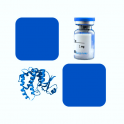
- Remove this product from my favorite's list.
- Add this product to my list of favorites.
Products
Viewed products
Newsletter
 |  |  |  |  |  |

Background
Stem Cell Factor is also known as SCF, kit-ligand, KL, steel factor, KITLG, FPH2, KL-1, Kitl, MGF, SCF, SF, or SHEP7, and is a cytokine that binds to the c-Kit receptor (CD117). SCF can exist both as a transmembrane protein and a soluble protein. This cytokine plays an important role in hematopoiesis (formation of blood cells), spermatogenesis, and melanogenesis. The soluble and transmembrane forms of the protein are formed by alternative splicing of the same RNA transcript.Soluble and transmembrane SCF is produced by fibroblasts and endothelial cells. Soluble SCF has a molecular weight of 18,5 KDa and forms a dimer. SCF plays an important role in the hematopoiesis during embryonic development. Sites where hematopoiesis takes place, such as the fetal liver and bone marrow, all express SCF. During development, the presence of the SCF also plays an important role in the localization of melanocytes, cells that produce melanin and control pigmentation. SCF plays a role in the regulation of HSCs in the stem cell niche in the bone marrow. SCF may be used along with other cytokines to culture HSCs and hematopoietic progenitors. The expansion of these cells ex-vivo (outside the body) would allow advances in bone-marrow transplantation, in which HSCs are transferred to a patient to re-establish blood formation.
Source
Recombinant Mouse SCF, His Tag (SCF-M5228) is expressed from human 293 cells (HEK293). It contains AA Lys 26 - Ala 189 (Accession # NP_038626).
Predicted N-terminus: Lys 26
Molecular Characterization
This protein carries a polyhistidine tag at the C-terminus.
The protein has a calculated MW of 19.5 kDa. The protein migrates as 19-30 kDa under reducing (R) condition (SDS-PAGE) due to different glycosylation.
Endotoxin
Less than 1.0 EU per μg by the LAL method.
Purity
>95% as determined by SDS-PAGE.
Formulation
Lyophilized from 0.22 μm filtered solution in PBS, pH7.4 with trehalose as protectant.
Reconstitution
See Certificate of Analysis for details of reconstitution instruction and specific concentration.
Storage
For long term storage, the product should be stored at lyophilized state at -20°C or lower.
Please avoid repeated freeze-thaw cycles.
This product is stable after storage at:
-20°C to -70°C for 12 months in lyophilized state;
-70°C for 3 months under sterile conditions after reconstitution.
Bioactivity
Please refer to product data sheet.
(1) "Immune Markers Are Associated With Asymptomatic Intracranial Large Artery Stenosis and Future Vascular Events in NOMAS"
Yang, Liu, Khasiyev et al
Stroke (2023)
(2) "Exploiting the Cullin E3 Ligase Adaptor Protein SKP1 for Targeted Protein Degradation"
Hong, Osa, Wertz et al
bioRxiv (2023)
(3) "Impact of Clinical Parameters and Induction Regimens on Peripheral Blood Stem-Cell Mobilization and Collection in Multiple Myeloma Patients"
Sauer, Hieke, Brandt et al
Transfus Med Hemother (2023) 50 (5), 382-395
Showing 1-3 of 10107 papers.
Follow us